He was to the East Side what Robert McCart was to the West Side, what Sam Rosen was to the North Side, what George C. Clarke was to the South Side: a real estate developer, an alchemist who transformed raw land into neighborhoods.
 Richard L. Vickery was born in England in 1850 and came to America about 1870, settling in Wisconsin, where he worked in lumber camps. By 1880 he had traded the ax for the spoon: He was living in Waxahachie and working as a confectioner.
Richard L. Vickery was born in England in 1850 and came to America about 1870, settling in Wisconsin, where he worked in lumber camps. By 1880 he had traded the ax for the spoon: He was living in Waxahachie and working as a confectioner.
In the 1880s, while still living in Waxahachie, he began buying and selling real estate in Fort Worth. He specialized in the area just beyond the eastern city limit, which back then was about a half-mile east of today’s Interstate 35W.
Vickery and/or his son Charles would develop several eponymous additions on the East Side: Vickery, Vickery Acres, Vickery Garden Tracts, Vickery Southeast.
 But Richard Vickery’s best-remembered addition was his first: Glenwood, which was located between the eastern city limit and Sycamore Creek and included Tyler’s Lake, a popular resort late in the nineteenth century. This 1895 map shows Union Depot, Glenwood, Tyler’s Lake, and Polytechnic College and Manchester Mills in the new community of Polytechnic.
But Richard Vickery’s best-remembered addition was his first: Glenwood, which was located between the eastern city limit and Sycamore Creek and included Tyler’s Lake, a popular resort late in the nineteenth century. This 1895 map shows Union Depot, Glenwood, Tyler’s Lake, and Polytechnic College and Manchester Mills in the new community of Polytechnic.
The Star-Telegram said that at one time Richard Vickery owned most of what became Glenwood. He bought up large tracts of rural land . . .
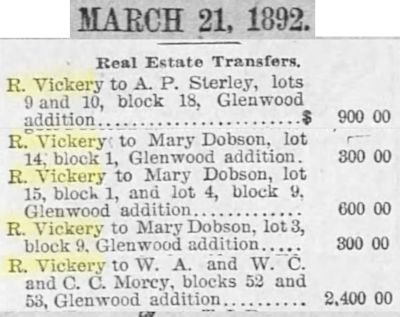 and platted them into town lots.
and platted them into town lots.
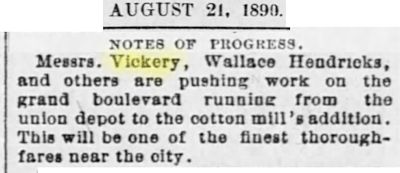 But his new addition needed a road to connect it to the big city to the west. So, in 1890 Vickery and others began work on a “grand boulevard” which would run about three miles from Union Depot east through Glenwood to Manchester Mills, which had just opened east of the new college. As the 1895 map shows, most of this thoroughfare was beyond the Fort Worth city limits. This was an ambitious project in 1890. The middle section of the boulevard would be finished soon enough, but its original builders would not live to see the east and west ends finished.
But his new addition needed a road to connect it to the big city to the west. So, in 1890 Vickery and others began work on a “grand boulevard” which would run about three miles from Union Depot east through Glenwood to Manchester Mills, which had just opened east of the new college. As the 1895 map shows, most of this thoroughfare was beyond the Fort Worth city limits. This was an ambitious project in 1890. The middle section of the boulevard would be finished soon enough, but its original builders would not live to see the east and west ends finished.
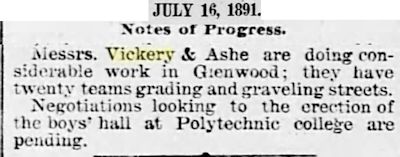 That “grand boulevard,” of course, was Vickery Boulevard.
That “grand boulevard,” of course, was Vickery Boulevard.
Richard Vickery and later his son Charles often developed additions along or close to mass transit lines: streetcars or interurbans.
But in the case of Glenwood, there was no mass transit line. So, Vickery built one.
 Vickery, S. C. Ashe (also of Waxahachie), and George Tandy (of Polytechnic) chartered the Glenwood and Polytechnic College streetcar company.
Vickery, S. C. Ashe (also of Waxahachie), and George Tandy (of Polytechnic) chartered the Glenwood and Polytechnic College streetcar company.
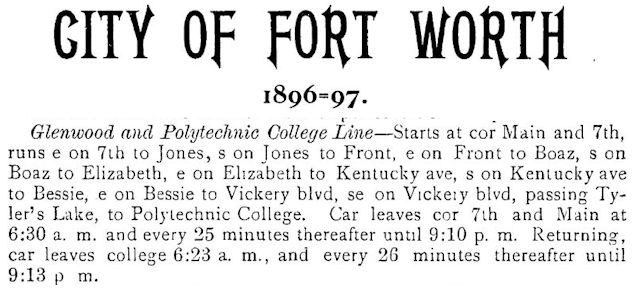 The track ran from downtown Fort Worth through Glenwood along Vickery Boulevard to Polytechnic College. The streetcar line was a brilliant idea: Students at the new college and workers at the new cotton mills needed a way to get to the big city. And they all had to ride Richard Vickery’s streetcars through Richard Vickery’s Glenwood.
The track ran from downtown Fort Worth through Glenwood along Vickery Boulevard to Polytechnic College. The streetcar line was a brilliant idea: Students at the new college and workers at the new cotton mills needed a way to get to the big city. And they all had to ride Richard Vickery’s streetcars through Richard Vickery’s Glenwood.
Glenwood prospered. The Gazette reported in October 1892 that Glenwood in eighteen months had grown from one house to fifty-four with seventy-two qualified voters (white male property owners).
By August 1894 the Gazette reported eight hundred residents.
By 1895 Glenwood had 150 homes, 750-1,000 residents, its own school district, a six-room schoolhouse, three churches, and an artesian well. Vickery Boulevard was “eighty feet wide and well graveled.”
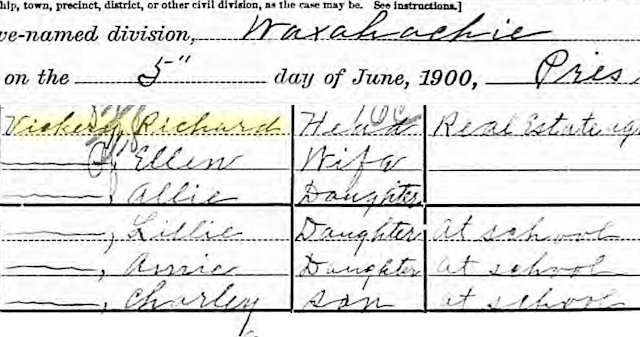 Meanwhile the Vickery family was still living in Waxahachie. Son Charles, born in 1884, was in school. The Vickerys would not move to Fort Worth until 1901. Waxahachie to Fort Worth was a long commute by horse and buggy in those days, although the two towns were connected by the Houston & Texas Central railroad.
Meanwhile the Vickery family was still living in Waxahachie. Son Charles, born in 1884, was in school. The Vickerys would not move to Fort Worth until 1901. Waxahachie to Fort Worth was a long commute by horse and buggy in those days, although the two towns were connected by the Houston & Texas Central railroad.
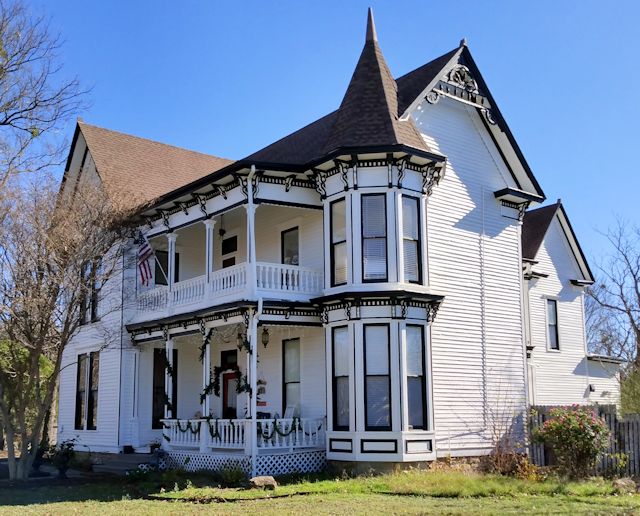 R. L. Vickery’s house in Waxahachie still stands.
R. L. Vickery’s house in Waxahachie still stands.
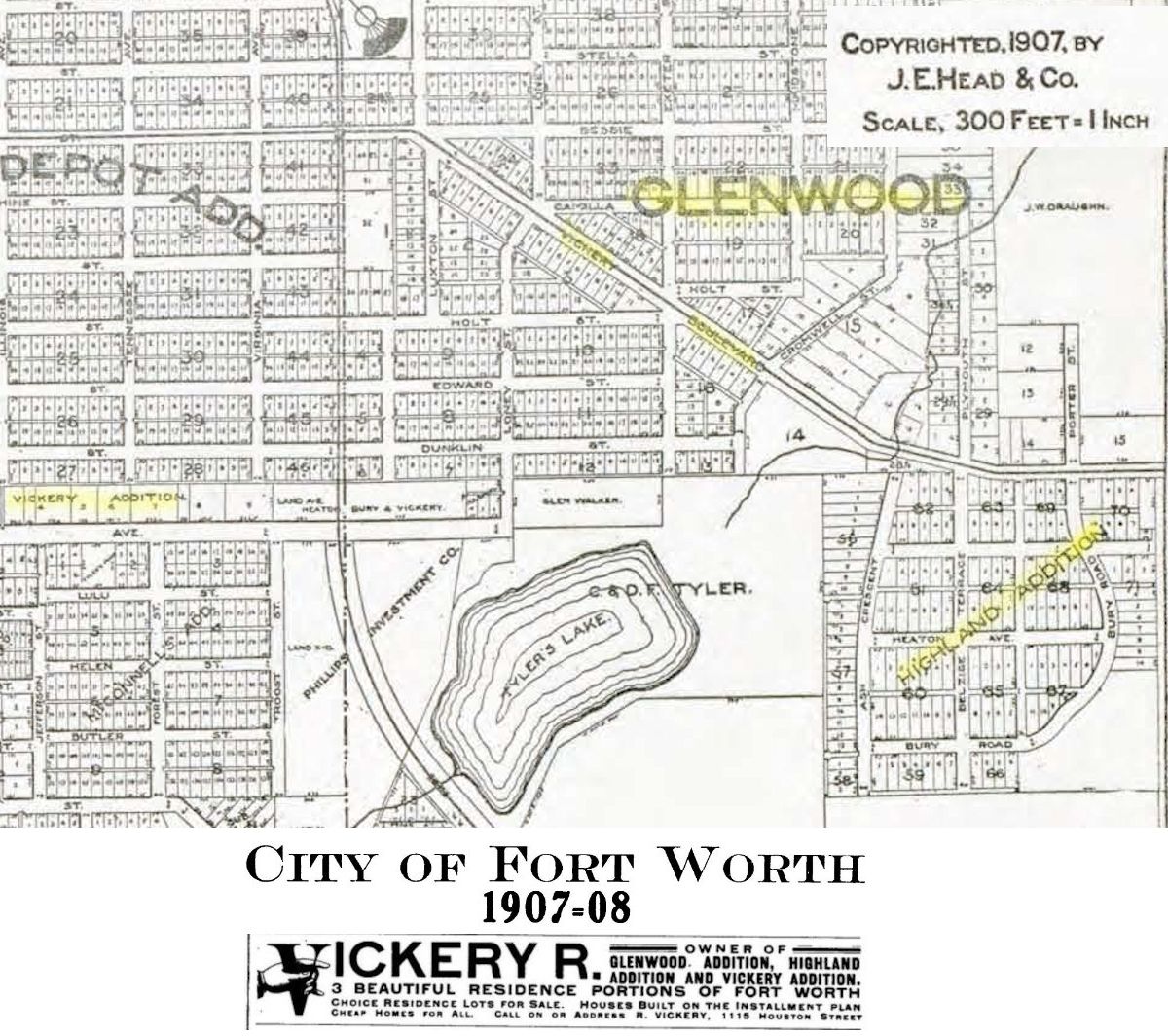 This 1907 map shows two other Richard Vickery additions: Vickery addition and Highland addition. At the top of the map are the roundhouse and turntable of the International & Great Northern railroad, which, with Hub Furniture, was a major employer in Glenwood.
This 1907 map shows two other Richard Vickery additions: Vickery addition and Highland addition. At the top of the map are the roundhouse and turntable of the International & Great Northern railroad, which, with Hub Furniture, was a major employer in Glenwood.
“Cheap homes for all,” the ad reads.
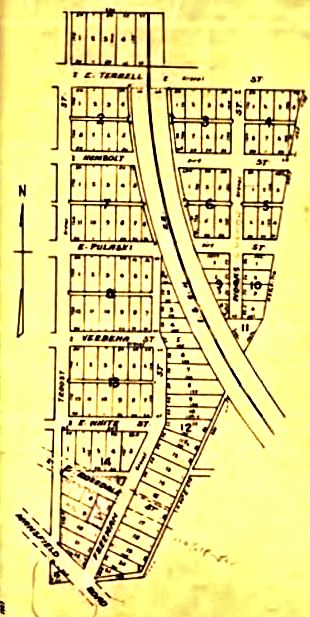 The Vickery addition is west of today’s Glenwood Park, which is located where Tyler’s Lake was (just west of South Riverside Drive).
The Vickery addition is west of today’s Glenwood Park, which is located where Tyler’s Lake was (just west of South Riverside Drive).
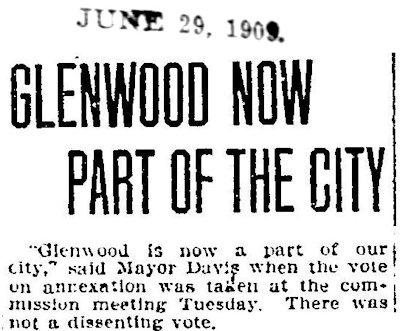 Early in the new century residents of Glenwood considered incorporation but instead began seek annexation by Fort Worth. In June 1909 Fort Worth annexed Glenwood and its school system.
Early in the new century residents of Glenwood considered incorporation but instead began seek annexation by Fort Worth. In June 1909 Fort Worth annexed Glenwood and its school system.
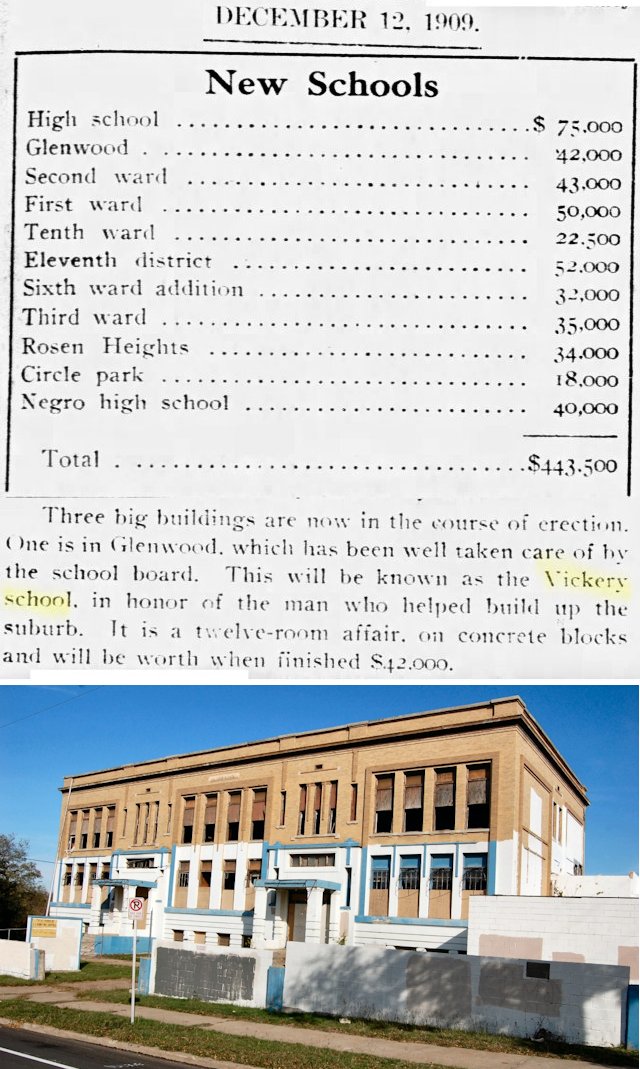 In 1910 Fort Worth built R. Vickery School at a cost of $42,000 ($1 million today) on—where else?—Vickery Boulevard. The school closed in 1985.
In 1910 Fort Worth built R. Vickery School at a cost of $42,000 ($1 million today) on—where else?—Vickery Boulevard. The school closed in 1985.
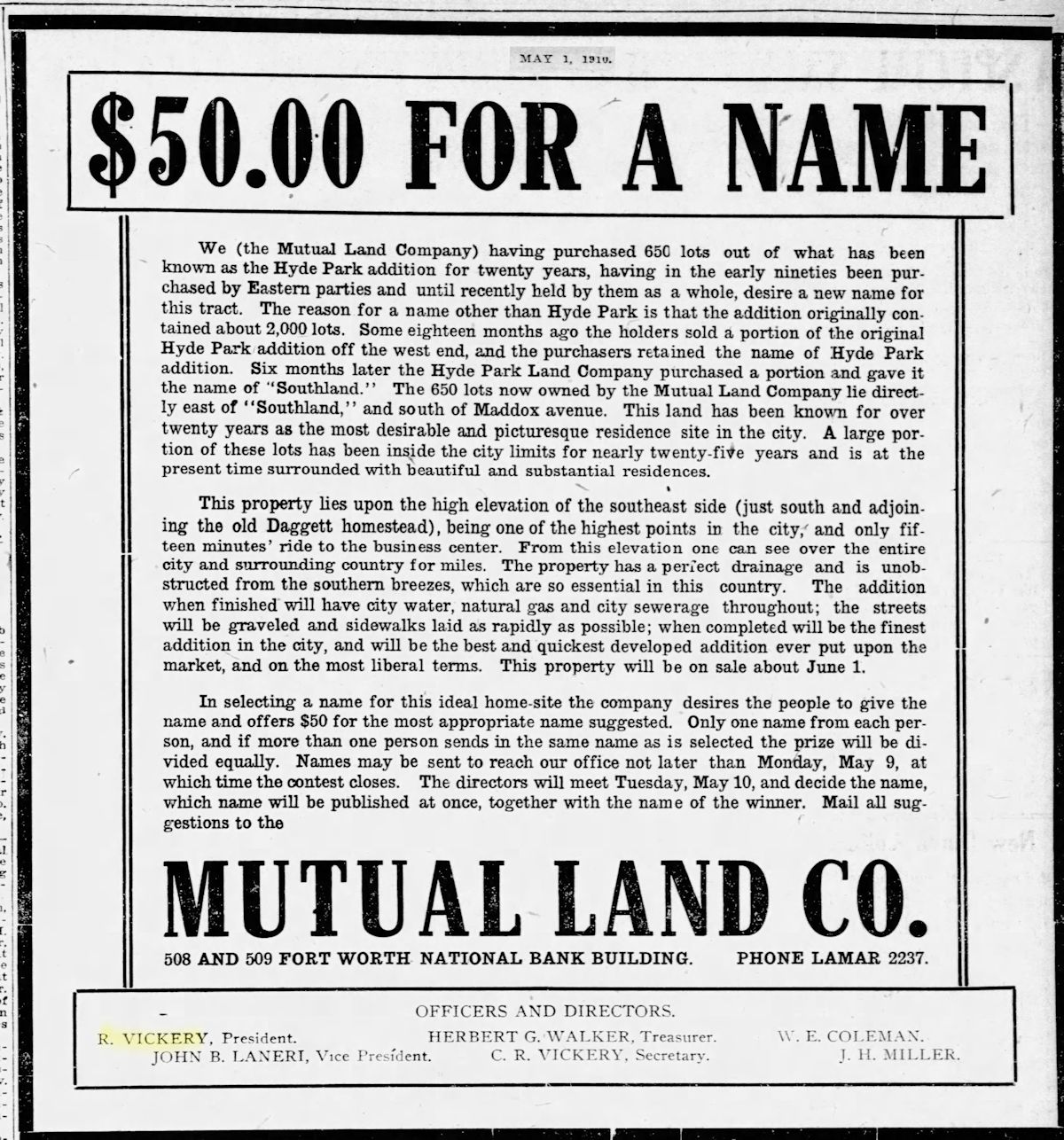 In 1910 Vickery’s Mutual Land Company announced that it had purchased a tract of the Hyde Park addition and would conduct a contest to select a new name for the tract. The person submitting the winning name would receive $50 ($1,400 today).
In 1910 Vickery’s Mutual Land Company announced that it had purchased a tract of the Hyde Park addition and would conduct a contest to select a new name for the tract. The person submitting the winning name would receive $50 ($1,400 today).
Note that son Charles Richard Vickery, who had joined his father in business in 1905, was secretary of the company. Pasta prince John B. Laneri was vice president.
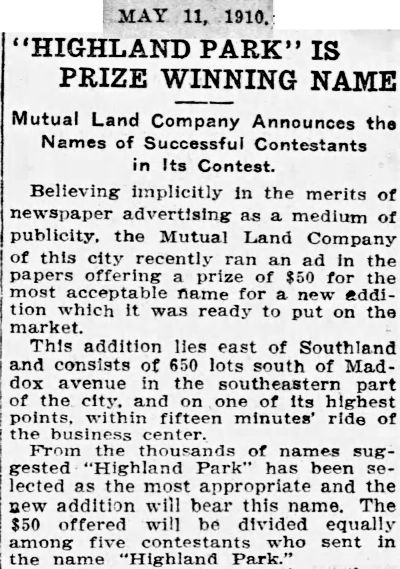 The winning name was “Highland Park.” Alas, five people submitted that name and had to split the $50 five ways.
The winning name was “Highland Park.” Alas, five people submitted that name and had to split the $50 five ways.
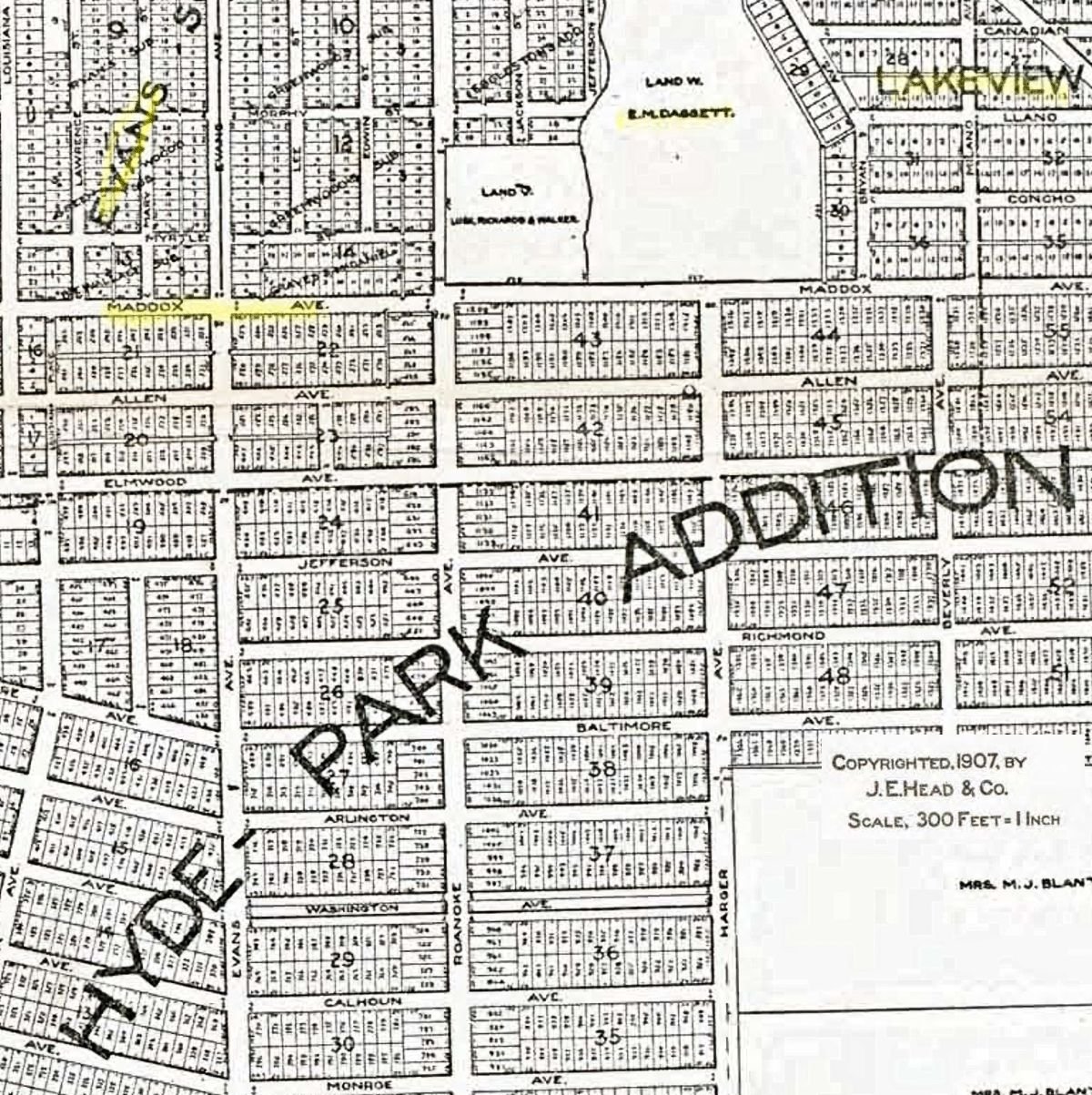 Hyde Park addition was south of Maddox Avenue and west of the I&GN track. Also shown are what was left of the old Ephraim Merrell Daggett homestead, J. L. Tyler’s Lakeview addition, and Sam Evans’s Evans South addition.
Hyde Park addition was south of Maddox Avenue and west of the I&GN track. Also shown are what was left of the old Ephraim Merrell Daggett homestead, J. L. Tyler’s Lakeview addition, and Sam Evans’s Evans South addition.
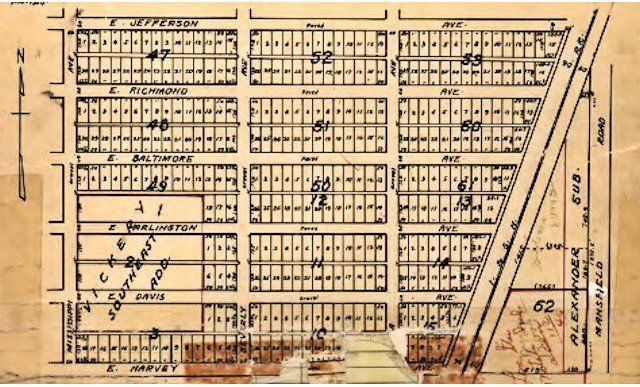 This plat shows Highland Park and Vickery Southeast additions south of Maddox Avenue and west of today’s South Riverside Drive.
This plat shows Highland Park and Vickery Southeast additions south of Maddox Avenue and west of today’s South Riverside Drive.
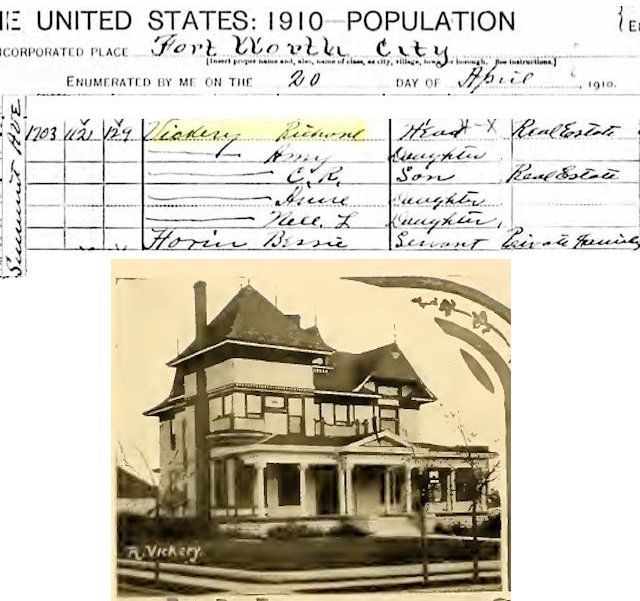 By 1909 R. Vickery was a wealthy man and living on a piece of prime real estate: 1703 Summit Avenue on Quality Hill.
By 1909 R. Vickery was a wealthy man and living on a piece of prime real estate: 1703 Summit Avenue on Quality Hill.
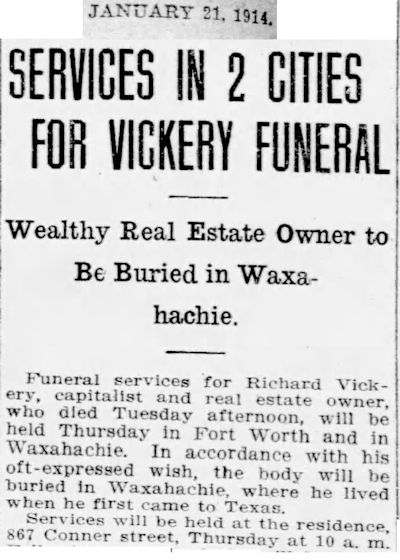 Richard L. Vickery died in 1914. By then he was back on the East Side, living on Conner Avenue in Poly.
Richard L. Vickery died in 1914. By then he was back on the East Side, living on Conner Avenue in Poly.
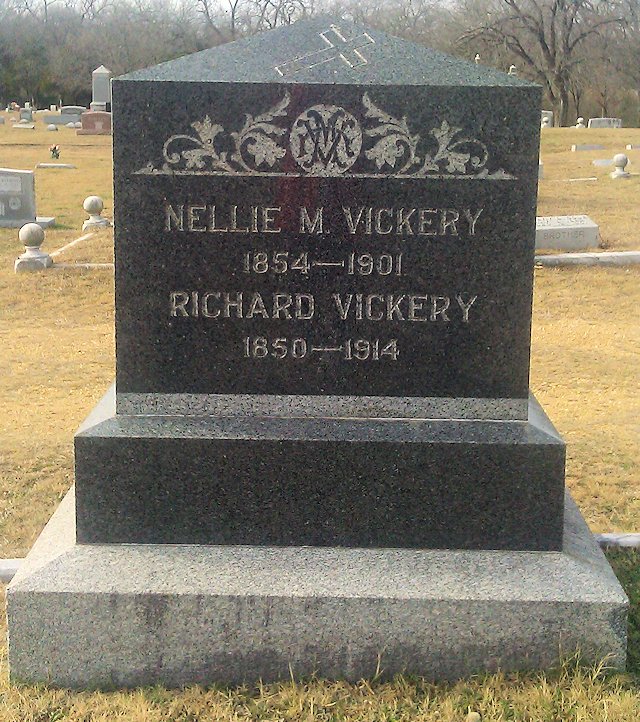 Richard L. Vickery is buried in Waxahachie City Cemetery.
Richard L. Vickery is buried in Waxahachie City Cemetery.
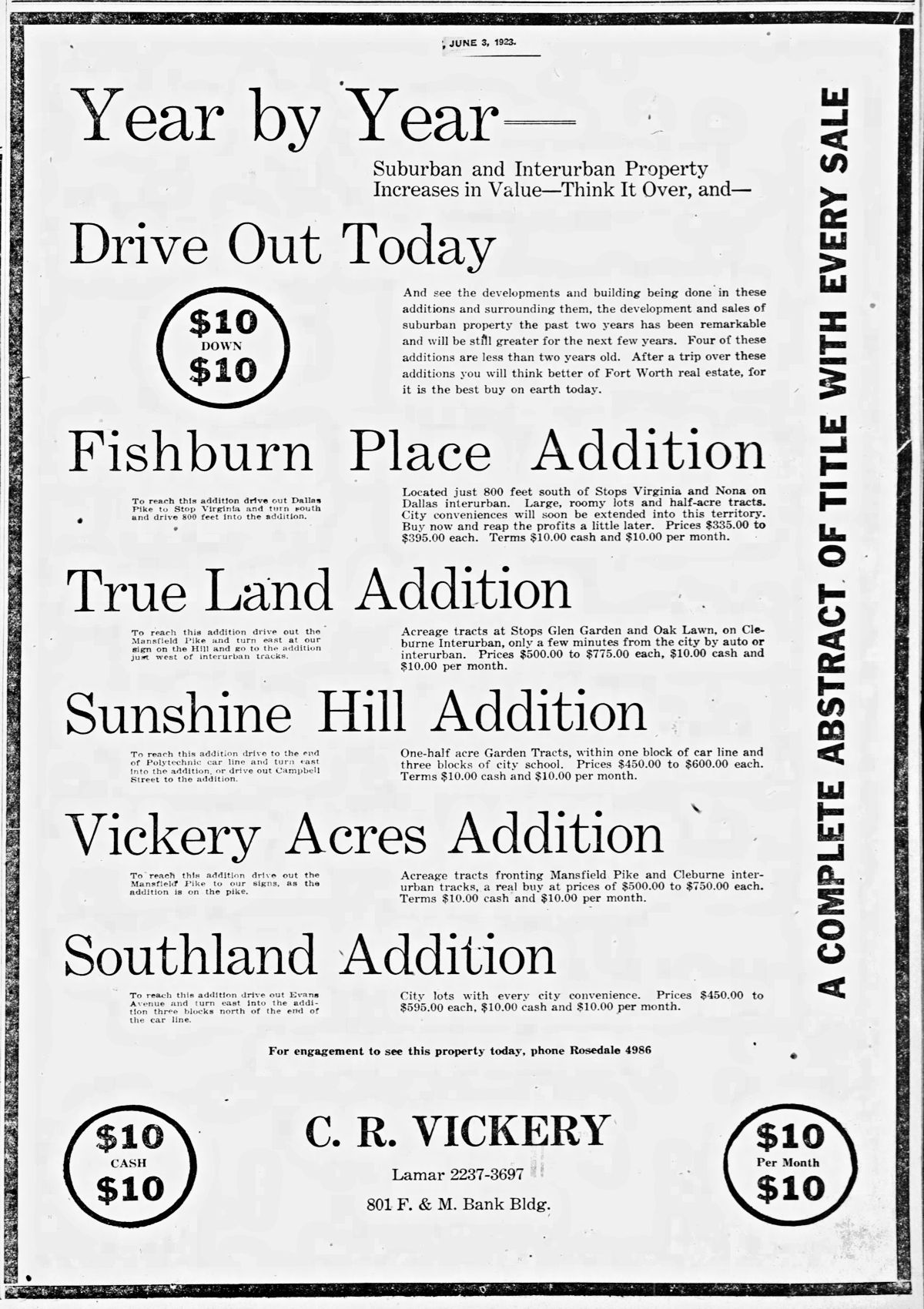 His son Charles carried on his work. Charles even expanded the traditional Vickery territory east into Meadowbrook and southeast even into Forest Hill.
His son Charles carried on his work. Charles even expanded the traditional Vickery territory east into Meadowbrook and southeast even into Forest Hill.
In 1923 he advertised five additions, selling city lots and “acreage tracts” for ten dollars down and ten dollars a month. Lots were priced from $335 to $775.
This ad shows how Charles, like his father, favored developing additions near streetcar or interurban lines. None of these six additions was more than three blocks from a streetcar or interurban line.
Fishburn Place was developed on the former horse farm and race track of dry cleaner William Bailey Fishburn. It was right on the Dallas interurban line.
Trueland addition is in southeast Fort Worth west of Wichita Street. Trueland Street runs parallel to Wichita Street. The Cleburne interurban line ran down Wichita Street.
Sunshine Hill is east of Bishop Street in Poly. It was at the end of the Polytechnic streetcar line, which ran down Bishop Street from Rosedale Street.
Southland is part of the original Hyde Park addition. It was three blocks from the Evans Avenue streetcar line.
Vickery Acres, like Trueland, was next to the Cleburne interurban line on Wichita Street (“Jackson Street” in 1923).
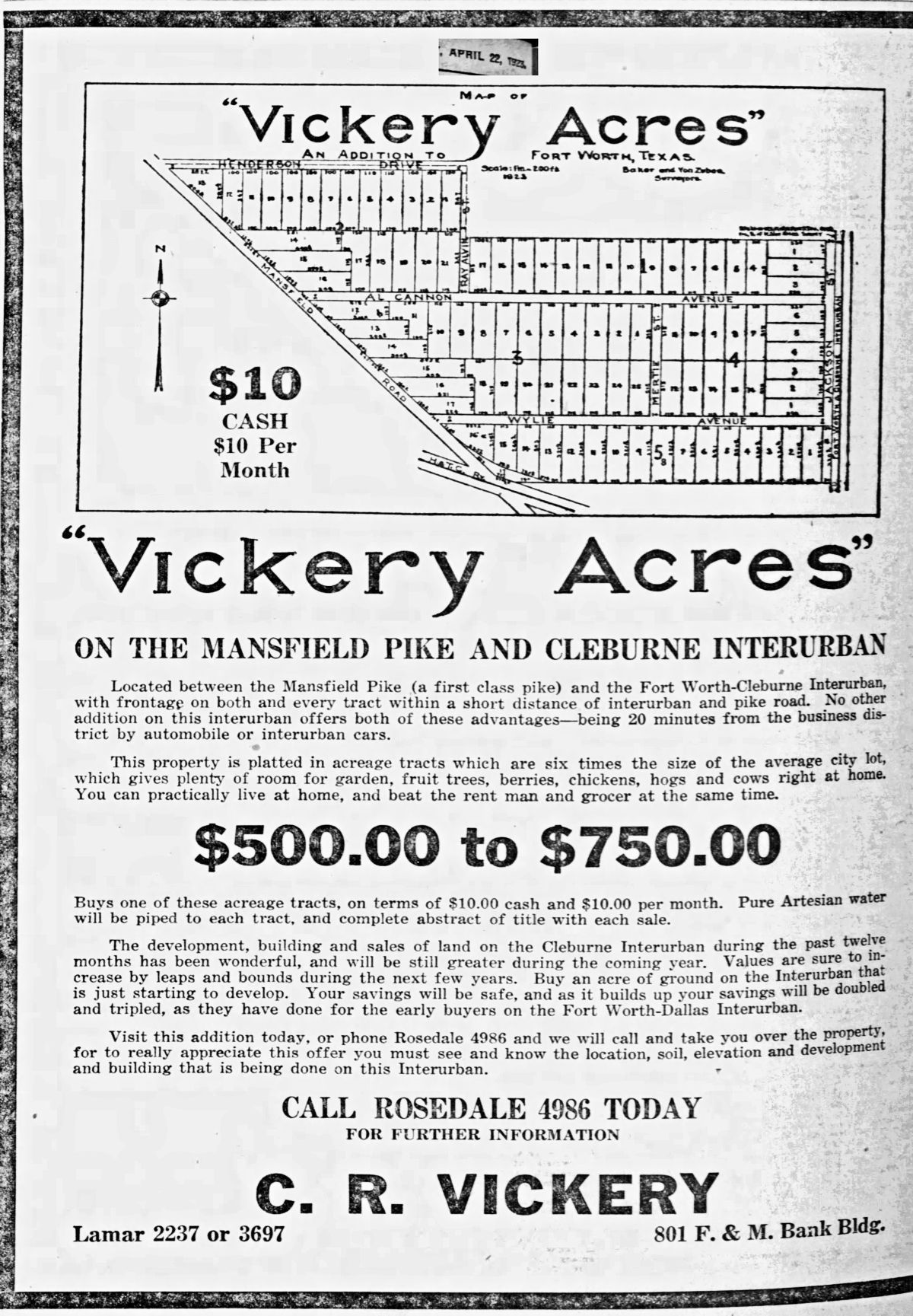 Vickery Acres is located west of Jackson Street (Wichita Street) and north of Mansfield Highway. But students of the old Glencrest Elementary School will recognize only one of the residential streets: Al Cannon Avenue.
Vickery Acres is located west of Jackson Street (Wichita Street) and north of Mansfield Highway. But students of the old Glencrest Elementary School will recognize only one of the residential streets: Al Cannon Avenue.
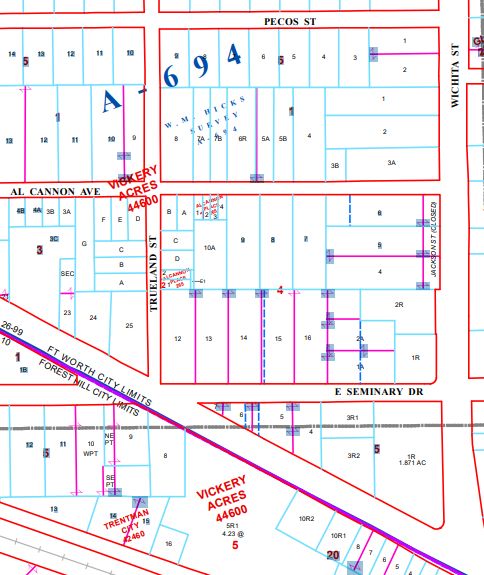 This Tarrant Appraisal District map shows Vickery Acres today extending south across Mansfield Highway into Forest Hill.
This Tarrant Appraisal District map shows Vickery Acres today extending south across Mansfield Highway into Forest Hill.
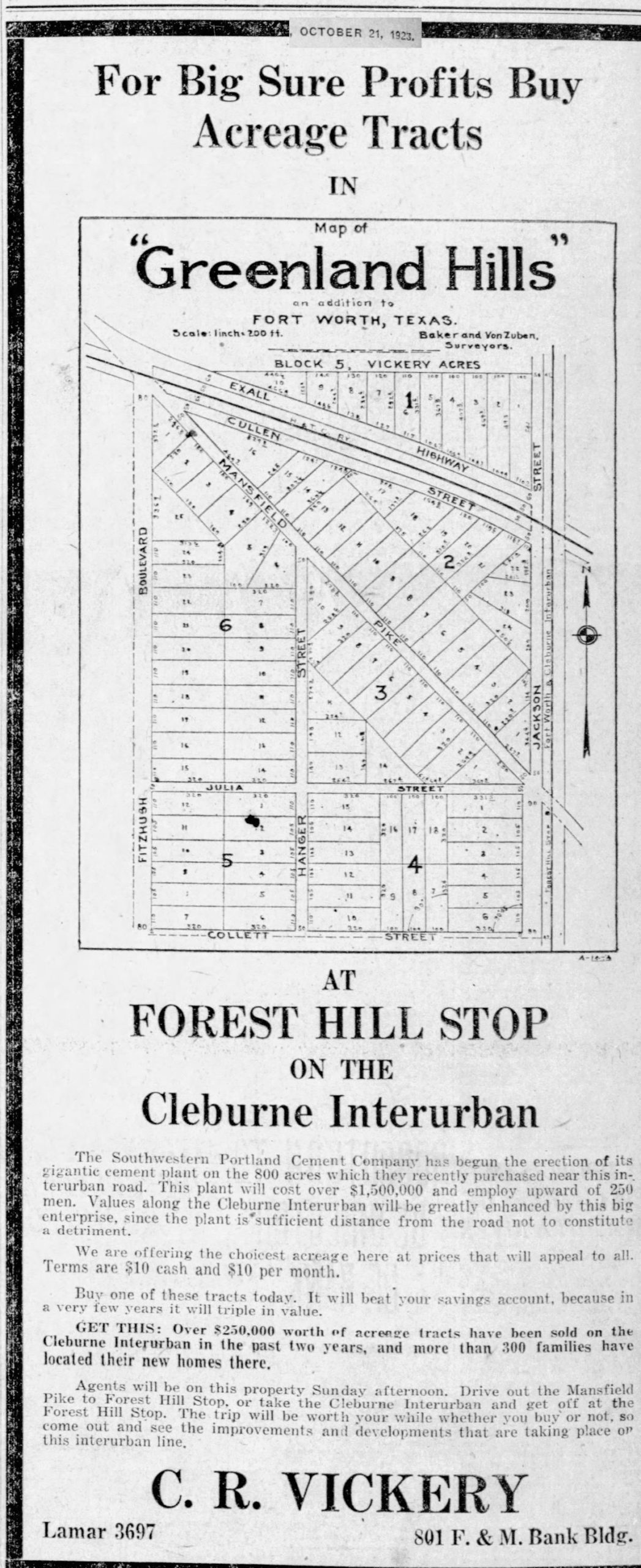 The map in this ad for Greenland Hills addition shows how streets change names and even disappear.
The map in this ad for Greenland Hills addition shows how streets change names and even disappear.
Of the streets labeled, only “Mansfield Pike” remains today (as “Mansfield Highway/Business 287”).
An East Sider might be especially perplexed by the map because “Fitzhugh” and “Hanger” are two streets that are two miles north of this location in Englewood Heights addition.
Note that Charles’s Vickery Acres was located to the north.
Connecting Loose Ends
 In 1890 Richard Vickery had envisioned a “grand boulevard” connecting Manchester Mills in Polytechnic with Union Depot in downtown Fort Worth—about three miles. But when he died in 1914 his namesake street still stretched only from Binkley Street in Poly west to Luxton Street in Glenwood—less than two miles.
In 1890 Richard Vickery had envisioned a “grand boulevard” connecting Manchester Mills in Polytechnic with Union Depot in downtown Fort Worth—about three miles. But when he died in 1914 his namesake street still stretched only from Binkley Street in Poly west to Luxton Street in Glenwood—less than two miles.
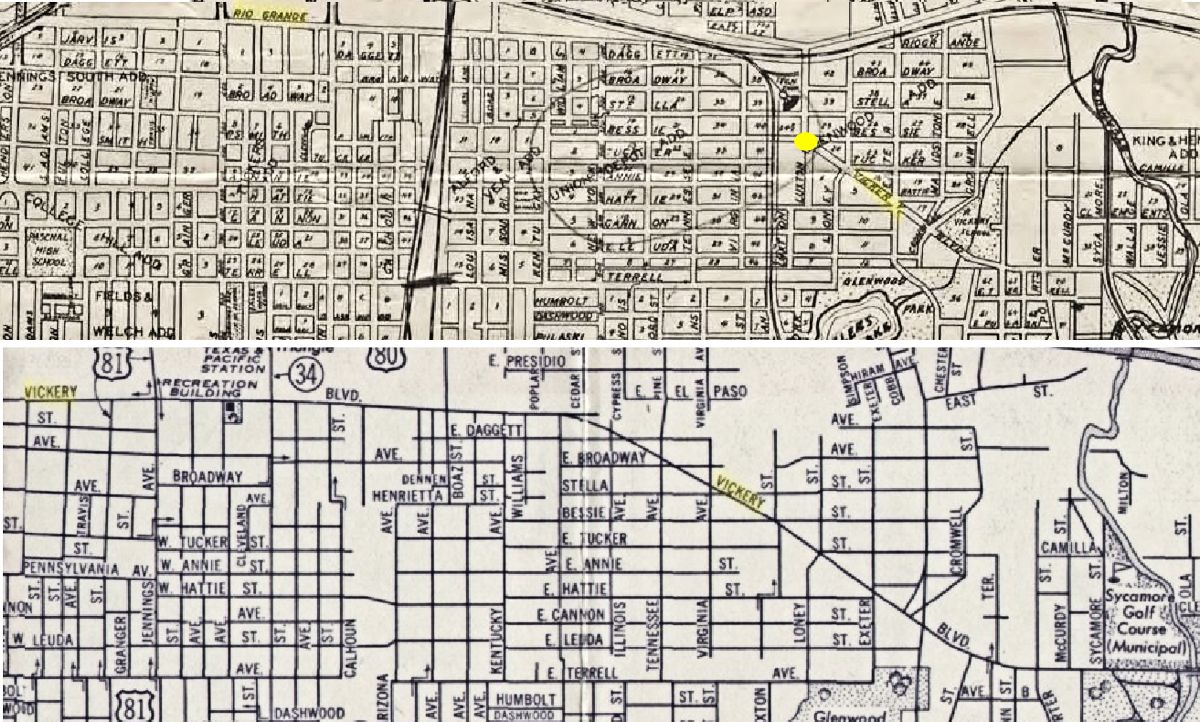 That remained the case even into the 1930s. The street south of downtown that we know today as “Vickery Boulevard” in the late nineteenth century was “South Street.” From at least 1901 to 1920 it was “Railroad Avenue.” And from at least 1925 to 1936 it was “Rio Grande Avenue.” And by any name it was not connected to Vickery Boulevard, which still ended at Luxton Street.
That remained the case even into the 1930s. The street south of downtown that we know today as “Vickery Boulevard” in the late nineteenth century was “South Street.” From at least 1901 to 1920 it was “Railroad Avenue.” And from at least 1925 to 1936 it was “Rio Grande Avenue.” And by any name it was not connected to Vickery Boulevard, which still ended at Luxton Street.
But by 1939 Richard Vickery’s 1890 vision had been reached—and exceeded. Vickery Boulevard was extended six blocks northwest to connect with the east end of Rio Grande Avenue, and the conjoined street was named “Vickery Boulevard” for its entire length from Poly to the West Side.
The top map is from 1936, the bottom map from 1939.
 By the time Charles Vickery died in 1945 his father’s namesake street stretched from the Texas & Pacific underpass in Poly west to the T&P Lancaster railyard.
By the time Charles Vickery died in 1945 his father’s namesake street stretched from the Texas & Pacific underpass in Poly west to the T&P Lancaster railyard.
 Today Vickery Boulevard is one of the longest east-west thoroughfares in town, stretching eleven miles from Ayers Avenue in Poly west to Winscott Road at Mary’s Creek (with a short interruption at Chisholm Trail Parkway and Union Pacific’s Davidson Yard).
Today Vickery Boulevard is one of the longest east-west thoroughfares in town, stretching eleven miles from Ayers Avenue in Poly west to Winscott Road at Mary’s Creek (with a short interruption at Chisholm Trail Parkway and Union Pacific’s Davidson Yard).






Hello,I have been trying to help my Grandmother in finding old pics of her home and finding out who lived in her home in 1918 when it was built. Her home is 701 Conner Avenue in Fort Worth,Tx
Thank you so much for your historical research. Richard Vickery was my great grandfather. I am the granddaughter of his youngest child Nell Vickery. I have heard many stories and you helped clarify the story of the railcar for me. Grateful for your work!
Thank you, Carol.
You know how I am about the street names in town….Interesting map that shows Fitzhugh and Hanger outside of Poly and running north to south….Odd that Fort Worth would rename them in Poly and change their orientation to run west to east….A good piece linking so much of the greater East Side ‘hood to the lynch pin Polytechnic Heights….
Thanks, Dan. That Greenland Hills ad is 1923. A 1925 map shows Greenland Hills to not yet be in the Fort Worth city limits. Maybe that explains how the two Hanger streets and two Fitzhugh streets co-existed until the post office, presumably, changed the two names in Greenland Hills. Also the two Hangers are/were “Street” and “Avenue,” and the two Fitzhughs are/were “Boulevard” and “Avenue.” Fun times at the central post office
My father and his sister grew up in the Vickery neighborhood. They attended R. Vickery school in the 1930s before they made the trip to California with my grandparents, for an imagined better life. My grandfather worked as a furniture builder at a shop on Vickery Street. The trip to CA was not one adventure, but of necessity in order to survive. Once in LA, they stayed three years and returned to Fort Worth, their hometown. FW is also my hometown and proud of it. Most of my relatives, cousins, etc lived in Poly. I grew up on Ryan Ave and attended George C. Clark, then later, Daggett Elementry.
We were so insulated in Poly growing up that I knew nothing about Glenwood, Tyler’s Lake, Daggett Elementary, etc. And forty years later when a Poly High classmate told me he had gone to George C. Clarke Elementary, I assumed he was talking about a school in another town. (In case Charley Strawn was a relative, I was telling a friend about Charley just yesterday-after Pony League baseball practice in Sycamore Park one day I watched Charley hang from the open passenger door of Tommy Bedford’s moving car and make sparks on the pavement of the road with his baseball cleats.)
My Irish grandmother Bridie and her family (including my mother) moved into Glenwood in 1920 at 1531 Bessie Street, which intersects Vickery Blvd. Her itinerant, gold-prospecting brother bought the house for her for about $3,000 after striking gold in Nevada. It had a flush toilet in a closet off the back porch, but no water heater. The brother returned to Nevada in a railroad boxcar, the same way he’d reached Fort Worth. My dad installed a water heater in the place in the early ’40s. The house stayed in the family until the mid-’50. A few years ago I met the family who lives in the 101-year-old house. As you recall, you ran a picture of it earlier this year in one of your colorful histories.
Thanks, Jim. For its size, Glenwood has produced a lot of stories.
Great story this am. Fort Worth owes you for your gift as our historian. Keep up the great work!!
Thank you for your kind words, Mr. Moncrief. And thank you for your public service to Fort Worth.